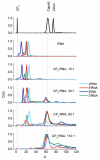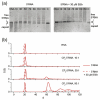Mutually-induced conformational switching of RNA and coat protein underpins efficient assembly of a viral capsid
- PMID: 20684044
- PMCID: PMC4793595
- DOI: 10.1016/j.jmb.2010.05.058
Mutually-induced conformational switching of RNA and coat protein underpins efficient assembly of a viral capsid
Abstract
Single-stranded RNA viruses package their genomes into capsids enclosing fixed volumes. We assayed the ability of bacteriophage MS2 coat protein to package large, defined fragments of its genomic, single-stranded RNA. We show that the efficiency of packaging into a T=3 capsid in vitro is inversely proportional to RNA length, implying that there is a free-energy barrier to be overcome during assembly. All the RNAs examined have greater solution persistence lengths than the internal diameter of the capsid into which they become packaged, suggesting that protein-mediated RNA compaction must occur during assembly. Binding ethidium bromide to one of these RNA fragments, which would be expected to reduce its flexibility, severely inhibited packaging, consistent with this idea. Cryo-EM structures of the capsids assembled in these experiments with the sub-genomic RNAs show a layer of RNA density beneath the coat protein shell but lack density for the inner RNA shell seen in the wild-type virion. The inner layer is restored when full-length virion RNA is used in the assembly reaction, implying that it becomes ordered only when the capsid is filled, presumably because of the effects of steric and/or electrostatic repulsions. The cryo-EM results explain the length dependence of packaging. In addition, they show that for the sub-genomic fragments the strongest ordered RNA density occurs below the coat protein dimers forming the icosahedral 5-fold axes of the capsid. There is little such density beneath the proteins at the 2-fold axes, consistent with our model in which coat protein dimers binding to RNA stem-loops located at sites throughout the genome leads to switching of their preferred conformations, thus regulating the placement of the quasi-conformers needed to build the T=3 capsid. The data are consistent with mutual chaperoning of both RNA and coat protein conformations, partially explaining the ability of such viruses to assemble so rapidly and accurately.
Copyright (c) 2010 Elsevier Ltd. All rights reserved.
Figures





Similar articles
-
Viral genomic single-stranded RNA directs the pathway toward a T=3 capsid.J Mol Biol. 2010 Feb 5;395(5):924-36. doi: 10.1016/j.jmb.2009.11.018. Epub 2009 Nov 12. J Mol Biol. 2010. PMID: 19913556 Free PMC article.
-
The three-dimensional structure of genomic RNA in bacteriophage MS2: implications for assembly.J Mol Biol. 2008 Jan 18;375(3):824-36. doi: 10.1016/j.jmb.2007.08.067. Epub 2007 Sep 7. J Mol Biol. 2008. PMID: 18048058
-
Dynamic allostery controls coat protein conformer switching during MS2 phage assembly.J Mol Biol. 2010 Feb 5;395(5):916-23. doi: 10.1016/j.jmb.2009.11.016. Epub 2009 Nov 12. J Mol Biol. 2010. PMID: 19913554
-
Simple rules for efficient assembly predict the layout of a packaged viral RNA.J Mol Biol. 2011 May 6;408(3):399-407. doi: 10.1016/j.jmb.2011.02.039. Epub 2011 Feb 25. J Mol Biol. 2011. PMID: 21354423 Review.
-
Breaking Symmetry in Viral Icosahedral Capsids as Seen through the Lenses of X-ray Crystallography and Cryo-Electron Microscopy.Viruses. 2018 Feb 7;10(2):67. doi: 10.3390/v10020067. Viruses. 2018. PMID: 29414851 Free PMC article. Review.
Cited by
-
Virus assembly, allostery and antivirals.Trends Microbiol. 2011 Jan;19(1):14-23. doi: 10.1016/j.tim.2010.11.003. Epub 2010 Dec 14. Trends Microbiol. 2011. PMID: 21163649 Free PMC article. Review.
-
Roles of the coding and noncoding regions of rift valley Fever virus RNA genome segments in viral RNA packaging.J Virol. 2012 Apr;86(7):4034-9. doi: 10.1128/JVI.06700-11. Epub 2012 Jan 25. J Virol. 2012. PMID: 22278239 Free PMC article.
-
Structural constraints on the three-dimensional geometry of simple viruses: case studies of a new predictive tool.Acta Crystallogr A. 2013 Mar;69(Pt 2):140-50. doi: 10.1107/S0108767312047150. Epub 2013 Jan 8. Acta Crystallogr A. 2013. PMID: 23403965 Free PMC article.
-
Direct Evidence for Packaging Signal-Mediated Assembly of Bacteriophage MS2.J Mol Biol. 2016 Jan 29;428(2 Pt B):431-48. doi: 10.1016/j.jmb.2015.11.014. Epub 2015 Dec 1. J Mol Biol. 2016. PMID: 26608810 Free PMC article.
-
Bacteriophage MS2 displays unreported capsid variability assembling T = 4 and mixed capsids.Mol Microbiol. 2020 Jan;113(1):143-152. doi: 10.1111/mmi.14406. Epub 2019 Nov 5. Mol Microbiol. 2020. PMID: 31618483 Free PMC article.
References
-
- Schneemann A. The structural and functional role of RNA in icosahedral virus assembly. Annu. Rev. Microbiol. 2006;60:51–67. - PubMed
-
- Harrison SC, Olson AJ, Schutt CE, Winkler FK. Tomato bushy stunt virus at 2.9 Å resolution. Nature. 1978;276:368–373. - PubMed
-
- Caspar DL, Klug A. Physical principles in the construction of regular viruses. Cold Spring Harbor Symp. Quant. Biol. 1962;27:1–24. - PubMed
Publication types
MeSH terms
Substances
Grants and funding
LinkOut - more resources
Full Text Sources

